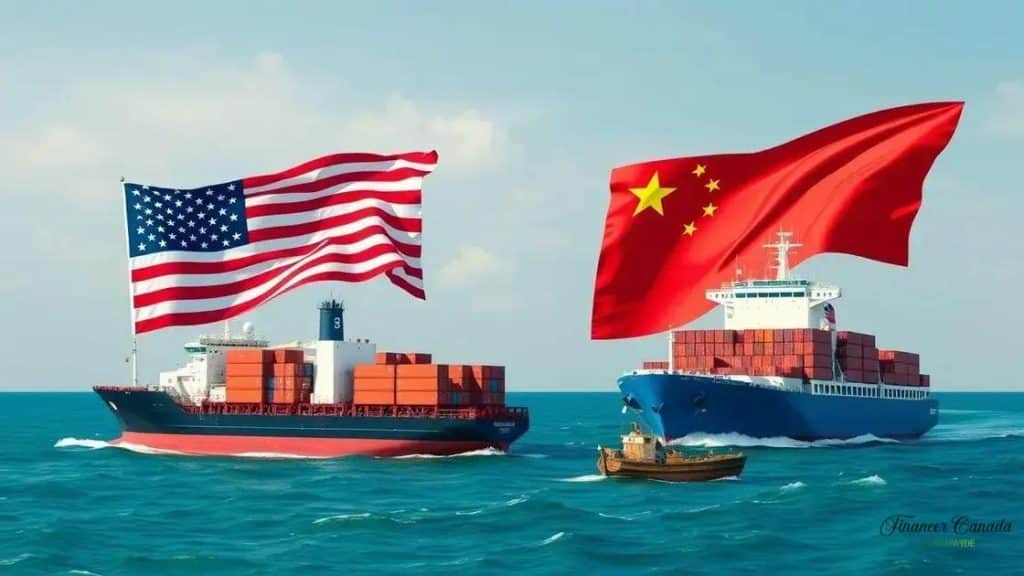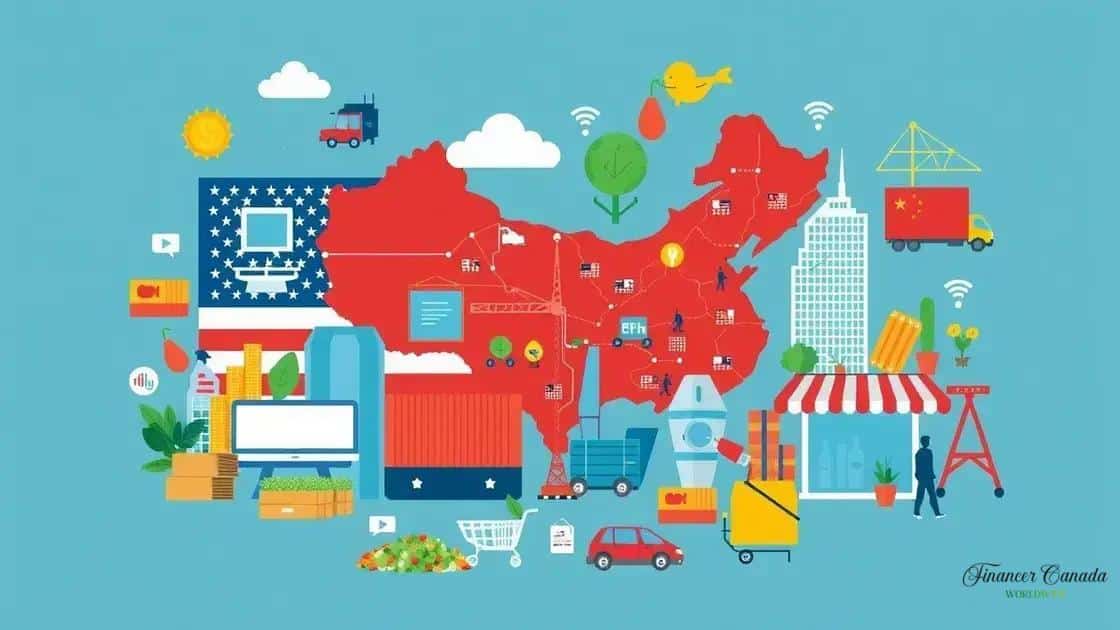US-China trade tensions and their global implications

US-China trade tensions involve tariffs, intellectual property disputes, and technology competition, impacting global economies and requiring businesses to adapt their strategies for future success.
US-China trade tensions are not just a bilateral issue; they ripple through global markets. Have you considered how these disputes might affect your daily life? Let’s unravel this complex situation together.
Understanding the origins of US-China trade tensions
To grasp the current US-China trade tensions, it’s essential to look back at their origins. The relationship between the two countries has a complex history, influenced by economic, political, and cultural factors.
Since China joined the World Trade Organization in 2001, the dynamics began to shift. The growth of China’s economy posed new challenges and opportunities for the United States and the global market.
Key factors influencing tensions
Several factors contribute to the ongoing trade disputes:
- Intellectual Property Theft: Concerns over China’s alleged theft of intellectual property ignited hostility.
- Trade Imbalances: The US has faced significant trade deficits with China, prompting demands for fairer trade agreements.
- Market Access: US firms often struggle to enter the Chinese market, leading to frustrations among American businesses.
These factors combined have led to rising tariffs and retaliatory measures. The US-China trade tensions symbolically represent a larger struggle for global economic dominance.
The role of technology
Technology has also played a significant role in escalating these tensions. Control over emerging technologies like artificial intelligence has become a strategic priority for both nations. The competition for technological superiority is viewed as essential to national security and economic growth.
China’s ambition to lead in technology has been met with skepticism from the United States, further complicating diplomatic relations. Trade restrictions on technology companies have become a point of major contention. With this focus on technology, both nations are now not just competing for economic leadership but also for global influence.
Public sentiment
Lastly, public sentiment in both countries has shaped these tensions. In the US, many citizens believe that China has unfair advantages and must be held accountable. Meanwhile, in China, the narrative often portrays the US as an aggressor seeking to contain China’s rise.
This mutual distrust complicates efforts for resolution and makes it increasingly difficult to achieve lasting solutions. As the stakes continue to rise, understanding the origins and factors behind the US-China trade tensions is crucial for navigating their future impact.
Key industries impacted by trade policies

The US-China trade policies have significantly impacted various industries, altering how they operate in a globalized market. Understanding these key industries can help us see the broader effects of the tensions between these two economic giants.
Technology Sector
One of the most affected sectors is technology. Sanctions and tariffs have changed the way companies engage in international trade. For instance, major US tech firms face barriers when attempting to sell their products in China.
- Smartphones: Companies like Apple have felt the impact as tariffs raise prices.
- Software: US software firms encounter restrictions on access to Chinese markets.
- 5G Technology: Rivalry over 5G technology dominance creates uncertainty in investments.
These changes not only affect profits but also influence global technological advancements and innovation.
Agricultural Industry
The agricultural sector is another crucial area impacted by trade rules. With tariffs in place, many farmers have had to adjust their production strategies. The United States and China are both significant players in global agriculture.
- Soybeans: US soybean farmers have faced major losses due to import tariffs imposed by China.
- Pork: Chinese tariffs on American pork have disrupted supply chains.
- Fruits and Vegetables: New trade barriers affect the cost and availability of various produce items.
This has led to greater price volatility and uncertainty in agricultural markets, affecting farmers’ livelihoods.
Manufacturing Industry
The manufacturing sector also bears the brunt of these trade policies. Many goods are manufactured in China and exported to the US. Tariffs increase costs for manufacturers relying on imported materials.
This can lead to higher prices for consumers and may push companies to seek alternative suppliers. As supply chains shift, many businesses are looking to relocate production to mitigate cost impacts.
Retail Industry
Retail also faces challenges as tariffs affect product pricing. Consumers often see these costs passed down to them, which can influence shopping habits. Retail sectors report fluctuating sales due to uncertainty regarding pricing.
The US-China trade policies create a ripple effect across various industries, compelling businesses to adapt swiftly to remain competitive. As these tensions evolve, the long-term impacts on these key industries will be crucial to watch.
Global economic consequences of the tensions
The global economic consequences of the US-China trade tensions are profound and far-reaching. These tensions disrupt not only the economies of the two nations but also ripple through the global market, affecting countries and industries worldwide.
Impact on Global Trade
One major consequence is the disruption of global trade flows. The imposition of tariffs leads to increased costs for businesses that rely on imported goods. Countries export less due to rising prices, which can slow down overall economic growth.
- Reduced Exports: Nations exporting to the US or China face challenges meeting their targets due to tariffs.
- Supply Chain Disruptions: Companies struggle to adapt their supply chains quickly, resulting in delays and inefficiencies.
- Trade Partnerships: Countries may form new alliances to mitigate impacts, altering traditional trade relationships.
This shifting landscape forces businesses to rethink their global strategies and adapt to new realities.
Effects on Investment
Foreign investment trends also shift due to uncertainty from trade tensions. Investors become cautious about where to put their money, looking for stability amidst the chaos. This can lead to decreased investments in key industries.
- Capital Flight: Investors may pull out from markets perceived as risky, leading to economic downturns.
- Delayed Projects: Companies might postpone expansions or new projects due to unclear future conditions.
- Emerging Markets: Some emerging markets might benefit as companies relocate operations to avoid tariffs.
As investment slows, economic growth can be stifled, affecting job creation and consumer confidence.
Currency Fluctuations
Another consequence of the rising tensions is increased volatility in currency markets. As news breaks regarding tariffs or negotiations, currencies can experience rapid fluctuations, impacting businesses that deal in multiple currencies.
These fluctuations can substantially influence import and export pricing, complicating budget forecasts for companies operating internationally.
Global Economic Growth
The overall growth rate of the global economy can be adversely affected by prolonged trade disputes. The International Monetary Fund (IMF) has noted that ongoing tensions could lower the growth rates of affected economies.
Countries heavily reliant on trade may notice GDP reductions, which can lead to lower living standards and shrink economic opportunities for their citizens.
In summary, the global economic consequences of the US-China trade tensions highlight the interconnectedness of the world economy. Businesses, consumers, and governments must adapt to a new normal as these tensions continue to evolve.
Strategies for businesses amid rising tariffs

Navigating the challenges posed by rising tariffs requires effective strategies for businesses. Understanding how to adapt to the US-China trade tensions is crucial for maintaining competitive advantage while ensuring profitability.
Diversifying Supply Chains
One effective strategy is diversifying supply chains. Businesses should not rely solely on one country for their manufacturing and sourcing needs. By spreading operations across multiple countries, companies can mitigate risk.
- Alternative Suppliers: Identify and establish relationships with suppliers in different regions.
- Local Sourcing: Whenever possible, source materials closer to home to avoid tariffs.
- Flexible Contracts: Make agreements with suppliers that allow for flexibility in case of tariff changes.
This flexibility enables businesses to adapt quickly to any changes in trade policies.
Increasing Efficiency
Another vital strategy is to enhance operational efficiency. By streamlining processes, companies can absorb additional costs related to tariffs without affecting their bottom line. Focusing on efficiency can lead to long-term savings.
Investments in technology and automation can also pay off, reducing labor costs and speeding up production times. This efficiency allows businesses to remain competitive even if prices rise due to tariffs.
Pricing Strategies
Adjusting pricing strategies is essential in a high-tariff environment. Companies may need to pass some costs onto consumers while remaining sensitive to the competition. Introducing tiered pricing or discounts on bulk purchases could help retain customers.
- Market Analysis: Regularly analyze pricing trends to ensure competitiveness.
- Customer Communication: Be transparent with customers about price changes to maintain trust.
- Value Addition: Emphasize quality and service to justify price increases.
Creating a clear communication strategy can work wonders in retaining consumer loyalty as prices fluctuate.
Exploring New Markets
Adventuring into new markets can provide opportunities for growth amidst rising tariffs. Identifying regions unaffected by the trade tensions can open doors to new customer bases. Exploring international markets can also reduce dependency on US and Chinese trade.
By diversifying market presence, companies can hedge against potential losses from tariffs. This strategy requires thorough research and understanding of local market dynamics to ensure successful entry.
Ultimately, businesses must remain adaptable in the face of rising tariffs. By integrating these strategies, companies can navigate the complexities of the US-China trade tensions more effectively, positioning themselves for long-term success.
Future outlook for US-China relations and trade
The future outlook for US-China relations and trade is a topic of great interest and concern. Given the complexity of their interactions, many factors will influence how these two nations move forward together.
Potential for Resolution
There is a possibility for resolution through diplomatic channels. Both countries might find common ground on key issues, such as trade agreements and technology sharing. Increased communication could lead to de-escalation, paving the way for a more collaborative relationship.
- Trade Talks: Negotiations may resume, focusing on tariff reductions and fair market practices.
- Joint Initiatives: Collaboration in areas like climate change can create shared interests.
- Economic Partnership: Businesses in both countries might advocate for stronger ties, emphasizing mutual benefits.
Such efforts might result in a more stable economic environment for both nations.
Challenges Ahead
However, significant challenges remain. Nationalism and domestic pressures may prevent leaders from making compromises. Political factors, such as upcoming elections, can shape policies, making it difficult to implement lasting changes.
- Political Climate: Changing administrations can lead to unpredictable foreign policies.
- Technological Competition: Continued rivalry in technology sectors may escalate tensions.
- Public Opinion: National sentiment may influence decisions, complicating negotiations.
These obstacles must be considered as part of the broader picture.
Impact on Global Trade
Any shift in US-China relations will significantly impact global trade flows. Countries worldwide will watch closely to adjust their strategies, understanding that stability in US-China relations promotes a healthier global economy. Changes in trade policies here affect commodities, investment patterns, and regional partnerships.
Global markets depend heavily on the interactions between these two economic powerhouses, making the future very uncertain.
Strategic Alliances
As a result, nations may explore new alliances to hedge against uncertainties. Countries affected by tariffs might seek alternatives to strengthen their own economies. This shift towards diversification can lead to new opportunities or unexpected challenges.
In summary, the future outlook for US-China relations is complex and multifaceted. Both opportunities for growth and challenges must be navigated carefully as these nations shape their paths forward. It will be crucial for businesses and policymakers to stay informed and adaptable as events unfold.
FAQ – Frequently Asked Questions about US-China Trade Relations
What are the main factors influencing US-China trade tensions?
The main factors include tariffs, intellectual property concerns, and competition in technology sectors.
How do rising tariffs affect consumers?
Rising tariffs typically lead to increased prices for goods, as businesses may pass the costs onto consumers.
What strategies can businesses use to adapt to trade tensions?
Businesses can diversify supply chains, improve operational efficiency, and explore new markets to mitigate the impacts.
What is the future outlook for US-China trade relations?
The future relies on diplomatic efforts, potential collaborations, and how both nations address ongoing challenges in their relationship.





